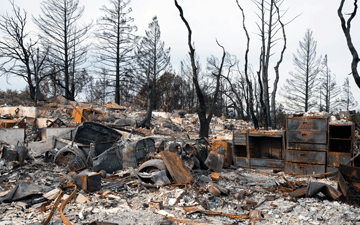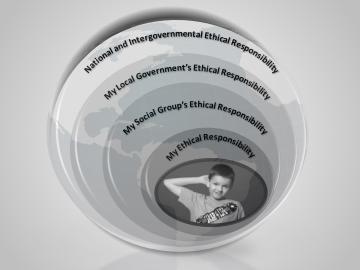
Yael Kidron is the director of Character Education at the Markkula Center for Applied Ethics. Views are her own.
As the count of people missing, injured, and dead in California’s wildfires grows, so do our worries that this tragedy is a part of a trend that scientists have repeatedly predicted. For some years, the California Department of Water Resources has projected more intense dry periods, these conditions are likely to increase wildfire risk in multiple regions of the state and dramatically reduce available water resources.
Just like in other states and parts of the world, California residents are divided in their attitudes towards policies for pro-environmental action in general, and in particular, wildfire prevention. For example, California Proposition 3, the California Water Infrastructure and Watershed Conservation Bond Initiative, which was recently defeated in the polls, highlighted the debate around shifting more of the burden of funding special projects, which may be more heavily concentrated in some parts of California, to the tax payer. Proposition 3 aimed to improve the conditions of rivers and streams, as well as existing water treatment facilities, dams, and canals. If implemented with quality, it had the potential to improve the health of people and wildlife.
As part of character education lesson plans, educators can prepare young people to participate in informed civil discourse about social and environmental responsibility. Equipped with improved abstract reasoning, cognitive flexibility, and social information processing skills, middle and high school students can debate the kinds of issues that they may face years later as voters at the polls.
There are multiple types of ethical dilemmas that students may address, which may be categorized using the Ecological Systems Model developed by Uri Bronfenbrenner.[1] This model may be presented graphically as several concentric circles with the person and his or her immediate social environment represented by the inner circles and the national or cultural environment represented by the outer circle. This model was created to demonstrate ecological effects on human development. Within the context of the development of youth’s character, this model can be used to describe how one’s values are embedded within the values and norms of one’s immediate and larger social environment, and how young people can gradually expand the focus of their ethical inquiries.

Moving outward from the smaller circles to the larger ones parallel in some ways the developing ability of students as they progress from concrete thinking about familiar everyday activities to the highest level of abstract thinking which involves international collaboration, policy formation, and multi-faceted humanitarian aid over extended periods of time.
Within the inner circle depicting “my personal responsibility,” younger students can consider what they can do. For example, how they can help ensure fire safety around their home as well as when hiking and camping; how they remind adults to test the batteries in smoke alarms; and what they need to do in case of fire.
Moving outward to the next circle that depicts “my social group’s ethical responsibility,” students can analyze dilemmas that tie to their friends, school, and after-school programs. Examples of dilemmas include:
- Should youth groups and youth clubs prioritize pro-environmental volunteering over other activities?
- What should you do when a friend gets a box of legally banned fireworks to use in his backyard on Fourth of July?
Moving up one level, students may examine ethical decision-making related to “my local government’s ethical responsibility.” Examples of dilemmas include:
- Should the burden for paying for fire prevention and suppression fees be evenly spread across all tax-payers, or should it be collected as special fees paid by landowners in fire-prone areas?
- Should special taxes be used to guarantee safe drinking water for all people, including those living in disadvantaged communities?
- Should local governments use tax payer money to subsidize climate-smart agriculture and low-carbon transportation?
Ethical dilemmas that may be categorized within the outer circle may address international and intergovernmental issues. Examples of dilemmas include:
- Should governments pass pro-environmental laws that may negatively impact disadvantaged populations in the short-term due to rising costs of housing, products, and food?
- Should governments invest in pro-environmental actions if they are the only countries in their region to do so?
- Should governments of countries suffering relatively less from climate change take measures that support countries that are affected significantly more?
Teaching modules may include the following components, to ensure deeper learning:
- How the ethical dilemma is identified and described.
- Students’ data collection and synthesis of facts.
- The identification of stakeholders and relevant special interest groups.
- The identification of short- and long-term costs and benefits.
- Explicit reference to ethical principles and moral virtues and how they inform the analysis.
- The justifications that students use when presenting their conclusions.
- How students connect the lesson to their lives and contemporary issues in the news.
Such educational activities may be integrated into different parts of the curriculum such as Earth Science, social studies, English language arts, and mathematics. In literature classes, encouraging students to read books and short stories about the interaction between the natural environment and the wellbeing of individuals and communities can expand students’ knowledge and reasoning skills. A relatively new genre of books, climate fiction (CliFi) or eco-fiction, can directly foster thinking about climate change. Classic novels may be used as well. For example, John Steinbeck’s The Grapes of Wrath, which portrays the struggles of the Dust Bowl farmers, can be discussed in terms of environmental impact on people and their livelihood. Stories can promote literary imagination – the exploration of the nature of places, events, and human behavior through being “transported” as an engaged reader to different places and times. Stories bring facts to life by exemplifying the effects of critical events on children and adults. For further details about the use of literature as part of ethics education, see the Character-Based Literacy Program page.
[1] Bronfenbrenner, U., & Morris, P. A. (2006). The Bioecological Model of Human Development. In R. M. Lerner & W. Damon (Eds.), Handbook of child psychology: Theoretical models of human development (pp. 793-828). Hoboken, NJ, US: John Wiley & Sons Inc.
